
|
Red Deer The Ecology of Red Deer Cervus elaphus INTRODUCTION
HISTORY AND DISTRIBUTION The Cervidae family has been evolving since the early Miocene era about 20 million years ago, with the actual Cervus genus really becoming recognizable during the Pliocene era 12 million years ago. It should be noted that in this pre-Ice Age era, continents were still one land mass and this is probably why the genus has such a wide distribution. Red deer in what is now the United Kingdom survived the Ice Age and there was a large population in heavily wooded post-glacial Britain. As the human population expanded, so the need for food increased and Red deer became a favoured quarry. The success of the species since those days has been closely linked to the fortunes and favours of man. On the one hand man progressively removed the natural predators (bear, lynx, and wolf); but on the other, has hunted deer for food or for sport. It should be recognized that it is hunting that has ensured the survival of the species. In the seventeenth and eighteenth centuries, when food was scarce, it was royal protection of the aristocracy’s privilege to hunt for sport that ensured Red deer were not hunted to extinction. Whilst no one might applaud the social injustices of that era, at least Red deer remained indigenous. Red deer are one of the most widely distributed deer in the world, stretching throughout the Eurasian temperate zones from New Zealand to northern Europe. Although the former is as a result of an artificial introduction, the remainder are mostly indigenous and are broken down into 12 subspecies. These differ in size, appearance and habits, with food availability and environment directly influencing their evolution. The Red deer distributed across the UK are a subspecies distinct to this country, Cervus elaphus scoticus. The largest density of Red deer and that group most readily associated with British Red, resides in Scotland. However a significant number of Red are spread throughout other parts of the country, for example in the New Forest, on Exmoor, the Quantocks, Suffolk, and the Lake District. Many of these often isolated groups have at various times been supplemented by introduced stocks or escapees from deer parks. The most ‘pure’ of these groups is probably to be found in the Lake District. But even the largest of these groups outside of the Highlands, around Exmoor and the Quantocks (approximately 3,000 in 1995), cannot compare with the estimated 300,000 Red deer living wild in Scotland. These Scottish deer, although by nature woodland dwellers, have been forced to adapt to a moorland environment due to the demise of the great Caledonian forests and, as a result, they are smaller. This is partly due to the poorer quality nutrition available on the open moor, which is ironically referred to as ‘deer forest’. DESCRIPTION
Calves are spotted at birth but generally loose these spots after about 2 months. When they are born, hill calves will weigh approximately 6.5kg, but the birth weight might be double this in the case of lowland forest deer. These weights are affected by the spring weather and the mother’s condition during the previous autumn. Amongst adults, the size of mature hinds can vary between 42-54cm at the shoulder and they can weigh between 57–115kg (125–250lbs). Stag weights vary between 90–190kg (200–420lbs), with hill Red rarely weighing more than 300lbs. These weights are traditionally measured in stones (one stone = 14 lbs) and pounds. The height at the shoulder of mature stags will be between 101–112cm (41–54in). Once again the significant difference in size is mainly indicative of whether they are moorland or woodland dwelling deer. As with Sika deer, immediately prior to the rut the stag’s neck visibly thickens and a mane develops. This has probably evolved as a result of the extra muscle and protection required when fighting during the rut. It is certainly accompanied by or linked to a significant increase in testosterone levels. There are some unusual pelage colour variations that can mostly be found within herds of park deer and these include white, cream and albino. The albino can be being distinguished from the white by its pink eyes and nose. Red, in common with other deer species, have a number of external glands; these include sub-orbital (below the eyes), preputial (reproductive organs), metatarsal (on the lower back leg), and interdigital (between the cleaves of the hooves). These organs are used to mark areas, indicate mating availability and possibly allow recognition of individuals. A fluid gait allows the animal to trot very long distances without strain. They are also strong swimmers, most noticeably demonstrated in the successful colonization of the islands off the coast of Scotland. The gait and stance of deer are also good indicators of age and condition. As you might expect, those with an alert, head-high stance (coupled with other indicators) are probably young and in good condition, whereas the long-faced deer with head down is probably past its prime. Red deer can have a life span of over 20 years, however this is unusual and they rarely live beyond 15 years. The highest period of mortality is in their first year, with over 80% of these deaths occurring within the first week of birth. Vulnerability during this period is dependant upon weather and predation. Both foxes and golden eagles have been known to take newborn calves. Late born calves are more likely to succumb. Hinds will normally breed between the ages of three and 13 years of age, whilst stags will normally mate between the ages of five and 11, although stags as young as one year will attempt to mount if the opportunity arises. After getting through the first year it is not until the age of eight that natural mortality starts to increase. Generally death by old age is governed by the deer’s ability to consume food which is determined by tooth wear. HABITAT AND FOOD It has already been stated that Red deer are by nature forest dwellers, however they are highly adaptive. Their selection of habitat is mostly linked to the availability of food, but other factors such as weather and fly infestation can also influence movement. Red will retreat to higher ground or deeper woodland during the height of summer to avoid flies, returning to lower or more open ground when food becomes scarce and the weather inclement. Their daily movement pattern will lead them from the lower, more sheltered areas where they spend the nights, back to higher sunny slopes where they spend the day feeding, resting and chewing the cud. These daytime resting areas will normally be good vantage points from which they can easily see approaching danger. They will also feel more secure if there is a fairly constant wind. Once the wind becomes unpredictable or above approximately Force 4 they will become agitated and move. This preferred daily and seasonal movement can be severely affected by human disturbance in the form of fencing or excessive disturbance by hill walkers and this in turn can cause sufficient stress to affect the condition of the deer. Red deer are grazers by preference, however good grass is not always available so many other food sources are taken advantage of. These include rough grasses (Molinia and Scirpus cespitosus) as well as heather and dwarf shrubs. Heather is of particular dietary importance during the dormant winter months, especially when snow covers the ground. If the weather is especially harsh, stags can be forced from the hill to maraud farm crops, most usually at night. During the winter months the nutritional requirement of Red alters as do their metabolisms; differences in eating habits can also be distinguished between stags and pregnant hinds. Despite any slowing down of their metabolic rate, this does not prevent death from malnutrition, which normally occurs in the spring when resources are at their lowest. This can be exacerbated, as has happened in recent years, by successive cold, wet winters. It is the impact of cold wind and driving rain getting under the normally highly effective double coat of the deer that has the greatest debilitating effect. ANNUAL CYCLE
After a gestation period of approximately 235 days (eight months), a calf of approximately 6 kg will be born, as early as late May but with the majority born in early to mid-June. There is possibly a slightly higher proportion of male calves by 1-2%. This could be a natural compensation for the slightly higher mortality rate in stag calves. Immediately prior to the hind giving birth she becomes restless and begins to moan. The actual birth normally occurs with the hind standing. Afterwards the hind will lick the calf clean, clean any contaminated grass and within forty minutes the calf will begin to suckle. After about an hour and a half the placenta will be expelled and the hind will eat it and clean traces of it from the area. This fastidious behavior assists in concealing the calf from predators. As soon as possible the hind will then move the calf away from the birthing area. The average annual increase in population at the time of calving is 10-20% in hill Red, depending on area and the previous winter, and 30-33% in lowland Red. Suckling occurs every two to three hours during the first few days and reduces gradually thereafter. While suckling, hinds will eat the faeces and urine of their calves, once again minimizing the risk of scent attracting predators. Calves in farmed conditions can be weaned quickly but, in the wild, calves are weaned after five to seven months. Hinds that did not conceive (yeld hinds) continue infrequent suckling of the previous year’s calves well into their second year. Calves gain weight rapidly during the autumn months after their birth, putting on as much as 30kg before November. After that weight gain slows considerably during the winter months and this is probably governed by food availability and the higher energy levels required to keep warm. HEALTH Deer in their normal habitat are normally exceptionally healthy, far more so than most domestic livestock. That said, there are a number of parasites and diseases which can affect Red deer, albeit rarely. Ectoparasites include, ticks (Ixodes), keds (Lipoptaena), lice (Trichdectes), nasal bot fly (Cephenemyia auribarbis) and warble fly (Hypoderma diana). The latter two in this group can cause the deer great distress. The castor bean tick can be a carrier of Lyme disease, which can be dangerous to humans if contracted, the symptoms not recognized and therefore left untreated. The endoparasites relevant to Red deer include liver fluke, (Fasciola hepatica) lungworm (Dictyocaulus) and a number of nematoda (unsegmented worms like hookworm causing intestinal infection). Most of the above will cause discomfort but are unlikely to fatal. Very rarely, Red deer can also carry the three notifiable diseases, namely: Tuberculosis, Foot and Mouth and Anthrax. ANTLER DEVELOPMENT
Antlers are cast when testosterone levels fall
in mid-March through April, with older stags casting first. These
cast antlers are often mouthed and chewed by deer, particularly
where Antlers can also develop abnormally and the causes of this could be hereditary or due to injury, illness or nutritional deficiency. A number of specific antler abnormalities have been defined. A Hummel is a stag without antlers, also known as a ‘Nott’ in the West Country. They either do not have any pedicles or these are miniscule. Not having to grow antlers often means that they have greater body mass than normal stags. This abnormality is not a hereditary condition and Hummel’s can hold hinds and produce normal offspring. A Switch is a head with only main beams that have no tines or perhaps only brow tines. It indicates a deer that has either gone past it’s full potential or one that will never attain it. They are also referred to as ‘killers’ because without the necessary tines to lock with an opponent, these single spikes can pierce through the natural defence that tines provide. A Cromie is a head with a swept back, goat-like appearance that is normally associated with the Scottish islands of Islay and Arran. SOCIAL STRUCTURE Stags and hinds will generally remain in separate
herds for the majority of the year, between November and September,
coming together as soon as hormones levels rise in late The population density of Red deer, as with all other species, can vary greatly with the type of terrain and food availability. It can also vary considerably with the seasons or even from month to month. It is probably because there are so many variables that there is also a huge range in recommended stocking levels. Some examples of recommended acreages per deer are:
The following records of Red deer densities (number per km sq) are the result of a vantage point count by the Forestry Commission, FC Pamphlet 71.
A planning density and balance might therefore be: Hill (with no sheep), 1 deer to 50 acres. Lowland (agriculture and forest), 1 deer to 200 acres. Balance, 1 stag to 1.5 hinds (excluding young of less than 10 months of age). VOICE AND CALLS During the rut stags are heard to issue an impressive roar. This is a series of deep guttural sounds from one breath, which can be repeated many times. The roar can be given as a challenge, an indication of size and stature or to reinforce the winning of a fight. They can give a short bark of warning, but this is normally reserved for lesser stags that pose no real threat. Outside the rut they are generally silent with the exception of an occasional warning bark. When calving, hinds develop the calving bellow which is only heard at that time of year, but they can also give a warning bark when alarmed. HYBRIDIZATION One of the most emotive subjects in the deer world is the interbreeding of species, especially when one has been introduced. The most serious is the hybridization of Red with Sika deer (Cervus nippon). There is still a lot to be learned about hybridization, particularly why it happens in one area and not another. It has and continues to occur in the Lake District, the Knapdale area of Argylshire, the Great Glen, Galloway, and in the Wicklow mountains of Ireland. There is evidence of hybridization in the northerly areas of the New Forest, however the culprit Sika stags are thought to have migrated from Purbeck and not to be from those Sika in the South of the Forest. The main culprits are almost certainly wandering Sika stags that become isolated from their own hinds. This mixing of species continues to spread at over seven kilometers per year. It could be that, within this century it transpires that the only pure Red in Scotland could be those found on isolated islands. CONCLUSION There can be no doubt that the Red deer is Britain’s largest and most spectacular mammal. It has survived an ice age and almost constant hunting for millions of years. It is nothing if not a survivor. However, aside from the problems of hybridization, it also remains very much in the center of a number of contentious issues. It has been blamed for the prevention of the natural regeneration of the Caledonian pine forest, whilst sheep and rabbits seem able to stay out of the limelight. There is also a continuing debate about whether there are just too many deer in Scotland altogether. And finally, perhaps the most emotive of all, there is the issue of Red deer being hunted with hounds in the South West of England. Although secretive by nature it would appear not to be able to avoid the spotlight of controversy. ACKNOWLEDGMENTS George Macdonald (Camusericht Estate) - for the benefit of a lifetime’s experience on the hill. The Deer-UK team are grateful to David Pantlin for the use of the Red hind photographs in this article. The Deer-UK team are grateful to Mark Ravnkilde for the use of the Red stag in velvet photograph in this article. BIBLIOGRAPHY Clutton-Brock G&A, Red Deer: Behavior and Ecology of Two Sexes (Edinburgh University Press, 1982). Whitehead GK, Encyclopedia of Deer (Swan Hill Press, 1993). de Nahlik AJ, Wild Deer (Ashford Press Publishing, 1987). Luxmoore, E Deer Stalking (David and Charles Ltd, 1980). Delap P, Red Deer (British Deer Society, 1977). Forestry Commission Pamphlet 71.
|
|||||||||||||||||||||||||||||||||||||||||||||||||
| Countrysports and Country Life are indebted
to the producers of the Deer UK site for permission to publish the
excellent material on deer species from their site. We would also
like to acknowledge the original sources of some of this material. We recommend all stalking enthusiasts or persons simply interested in deer, to pay a visit to the Deer UK site http://www.deer-uk.com |
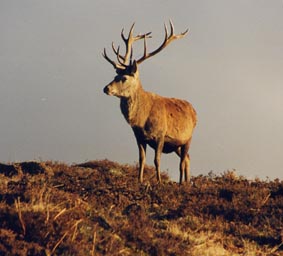 Of the six deer species living wild in the United Kingdom today,
only the Red (Cervus elaphus) and Roe (Capreolus capreolus)
can be called indigenous. The Red deer is the largest mammal in
Britain and has been here in some form or other since this island
was joined to mainland Europe. Red deer are proven survivors,
having struggled through the ice age, a period when their natural
woodland habitat was buried under ice and when almost every Briton
hunted deer. They overcame the effects of the former and learned
to avoid the latter. The ‘deer forests’ of Scotland are far removed
as a habitat from that which they would occupy out of preference
and yet they adapted in a relatively short period of time to the
point where they now have to be managed to prevent over-population.
It is because of the necessity for this management that our knowledge
of Red deer, as well as all other species, now becomes so important.
These notes deal specifically with Cervus elaphus scoticus,
one common subspecies that can be found in a number of areas throughout
Britain and Ireland.
Of the six deer species living wild in the United Kingdom today,
only the Red (Cervus elaphus) and Roe (Capreolus capreolus)
can be called indigenous. The Red deer is the largest mammal in
Britain and has been here in some form or other since this island
was joined to mainland Europe. Red deer are proven survivors,
having struggled through the ice age, a period when their natural
woodland habitat was buried under ice and when almost every Briton
hunted deer. They overcame the effects of the former and learned
to avoid the latter. The ‘deer forests’ of Scotland are far removed
as a habitat from that which they would occupy out of preference
and yet they adapted in a relatively short period of time to the
point where they now have to be managed to prevent over-population.
It is because of the necessity for this management that our knowledge
of Red deer, as well as all other species, now becomes so important.
These notes deal specifically with Cervus elaphus scoticus,
one common subspecies that can be found in a number of areas throughout
Britain and Ireland.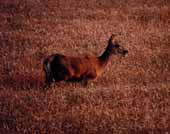 During the summer, Red deer
are dark red or brown with a lighter color of cream on the underbelly,
inner thighs and rump. There may also be some spots on the summer
coats, particularly along the spine. In winter, the pelage changes
to a darker brown or grey, with lighter patches on the rump and
undersides. It is notable that their caudal patch tends to reach
higher up the
During the summer, Red deer
are dark red or brown with a lighter color of cream on the underbelly,
inner thighs and rump. There may also be some spots on the summer
coats, particularly along the spine. In winter, the pelage changes
to a darker brown or grey, with lighter patches on the rump and
undersides. It is notable that their caudal patch tends to reach
higher up the 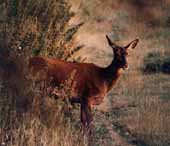 rump than is the case
with other deer. Both sexes have tails of approximately 15 cm
in length which are generally the same color as the caudal patch.
This tail may have a dark dorsal stripe that can extend upwards
along the spine. There is also a visible gland high on the cannon
bones (the long bone immediately above the hoof) of the rear legs.
Appearance can also be influenced by age and condition, for example
yearlings and calves have a shorter head due to having fewer teeth
in their jaw than an adult. Alternatively, when deer condition
begins to fail through age their coats will often appear
to be ginger in colour, even in the winter months.
rump than is the case
with other deer. Both sexes have tails of approximately 15 cm
in length which are generally the same color as the caudal patch.
This tail may have a dark dorsal stripe that can extend upwards
along the spine. There is also a visible gland high on the cannon
bones (the long bone immediately above the hoof) of the rear legs.
Appearance can also be influenced by age and condition, for example
yearlings and calves have a shorter head due to having fewer teeth
in their jaw than an adult. Alternatively, when deer condition
begins to fail through age their coats will often appear
to be ginger in colour, even in the winter months. In August the stags that up to this time of year have been living
in large stag groups start to become intolerant of each other.
An increased testosterone level causes this reaction, along with
an increase in neck and testicle size. This hormonal change is
also responsible for the cleaning of velvet from stags’ antlers.
As with most other aspects of a deer’s life cycle, this is governed
by photoperiod (the daily period of light and darkness). At this
time hinds begin to reduce their range and congregate in traditional
rutting areas. Shortly thereafter, in early September, stags ‘breakout-out’
from the stag groups and take possession of hind harems. Once
resident, these ‘master stags’ which are invariably between the
ages five and 11 years old, start defending their harem and herding
in any passing hinds. All of this rutting activity, which even
precludes eating, takes its toll on the condition of mature stags
and they can lose as much as 20% of their body weight during the
six week rutting period which peaks in mid-October. Fights between
stags are common and very often cause serious or fatal injury.
The severity of these fights is directly related to the degree
of threat, that is, the bigger the stag, the bigger the fight.
There are also a number of other activities that are associated
with the rut which are:
In August the stags that up to this time of year have been living
in large stag groups start to become intolerant of each other.
An increased testosterone level causes this reaction, along with
an increase in neck and testicle size. This hormonal change is
also responsible for the cleaning of velvet from stags’ antlers.
As with most other aspects of a deer’s life cycle, this is governed
by photoperiod (the daily period of light and darkness). At this
time hinds begin to reduce their range and congregate in traditional
rutting areas. Shortly thereafter, in early September, stags ‘breakout-out’
from the stag groups and take possession of hind harems. Once
resident, these ‘master stags’ which are invariably between the
ages five and 11 years old, start defending their harem and herding
in any passing hinds. All of this rutting activity, which even
precludes eating, takes its toll on the condition of mature stags
and they can lose as much as 20% of their body weight during the
six week rutting period which peaks in mid-October. Fights between
stags are common and very often cause serious or fatal injury.
The severity of these fights is directly related to the degree
of threat, that is, the bigger the stag, the bigger the fight.
There are also a number of other activities that are associated
with the rut which are: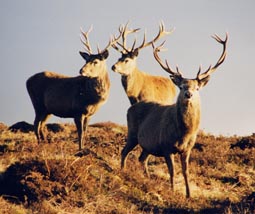 Red stags can appear the most majestic of animals when they are
carrying a full ‘rack’ and the thick mane that appears during
the rut. It is a sight that inspired Landseer to paint one of
the most famous animal portraits of all time, Monarch of the
Glen. There exists a significant difference between highland
and lowland deer antler growth, with the better highland stags
only expected to achieve 12 points (a ‘Royal’), whereas
lowland deer can achieve many more points with much greater mass.
This great mass of bone (not horn) has to be grown annually and
requires considerable nutrition to sustain it.
Red stags can appear the most majestic of animals when they are
carrying a full ‘rack’ and the thick mane that appears during
the rut. It is a sight that inspired Landseer to paint one of
the most famous animal portraits of all time, Monarch of the
Glen. There exists a significant difference between highland
and lowland deer antler growth, with the better highland stags
only expected to achieve 12 points (a ‘Royal’), whereas
lowland deer can achieve many more points with much greater mass.
This great mass of bone (not horn) has to be grown annually and
requires considerable nutrition to sustain it.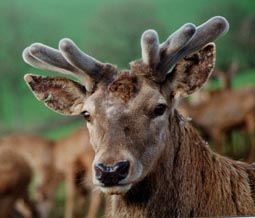 there is a calcium
deficiency in the diet. Almost as soon as antlers are cast, new
velvet-covered replacements begin to emerge. Velvet is a soft,
blood-filled bone forming tissue that is very sensitive. If there
is a conflict at this time stags will ‘box’ each other with their
front feet to protect these sensitive antlers. This behaviour
has probably been learned from hinds as they box to establish
the female pecking order within a herd. Once the stags’ antlers
have grown to full size, usually by July, the blood supply to
the antlers is stopped and they begin shedding or cleaning the
velvet. In woodland dwelling deer, fraying (that is the rubbing
of this dead and now irritating velvet against trees) can assist
this, but it is not one of the Red deer’s most endearing features
for foresters. This process will not start to occur until after
the second year; in their first year stag calves will start to
develop the pedicles (knobs of bone on the skull) that will eventually
carry the antlers and these become visible during their first
winter. In their second year they are known as a Knobber (or brocket)
for obvious reasons. Next is the ‘spiker’ stage, which occurs
during the third year. Thereafter antlers should continue to grow
in length, weight and number of tines, until approximately the
seventh to ninth year (the sixth to eighth ‘head’), when a full
classical head should develop. These age guides apply to hill
deer; in ideal conditions they could be carrying multi-point heads
in their second year. By this time there should be a number of
points or tines on each antler. Working up from the pedicle, these
are called: the brow, bay, trey, sur-royal and crown (which could
consist of a number of tines at the top). In the West of England
this is termed as having ‘all its rights and three atop’. The
size and number of tines is once again predominantly influenced
by food and shelter, as has been proven by taking stags with relatively
poor heads from the hill to the luxury and comfort of a park environment.
there is a calcium
deficiency in the diet. Almost as soon as antlers are cast, new
velvet-covered replacements begin to emerge. Velvet is a soft,
blood-filled bone forming tissue that is very sensitive. If there
is a conflict at this time stags will ‘box’ each other with their
front feet to protect these sensitive antlers. This behaviour
has probably been learned from hinds as they box to establish
the female pecking order within a herd. Once the stags’ antlers
have grown to full size, usually by July, the blood supply to
the antlers is stopped and they begin shedding or cleaning the
velvet. In woodland dwelling deer, fraying (that is the rubbing
of this dead and now irritating velvet against trees) can assist
this, but it is not one of the Red deer’s most endearing features
for foresters. This process will not start to occur until after
the second year; in their first year stag calves will start to
develop the pedicles (knobs of bone on the skull) that will eventually
carry the antlers and these become visible during their first
winter. In their second year they are known as a Knobber (or brocket)
for obvious reasons. Next is the ‘spiker’ stage, which occurs
during the third year. Thereafter antlers should continue to grow
in length, weight and number of tines, until approximately the
seventh to ninth year (the sixth to eighth ‘head’), when a full
classical head should develop. These age guides apply to hill
deer; in ideal conditions they could be carrying multi-point heads
in their second year. By this time there should be a number of
points or tines on each antler. Working up from the pedicle, these
are called: the brow, bay, trey, sur-royal and crown (which could
consist of a number of tines at the top). In the West of England
this is termed as having ‘all its rights and three atop’. The
size and number of tines is once again predominantly influenced
by food and shelter, as has been proven by taking stags with relatively
poor heads from the hill to the luxury and comfort of a park environment.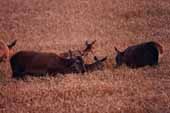 September. There are of
course always exceptions and it is not unusual for younger stags
to be seen around hind groups, indeed larger separate gender groups
will tolerate each other if feeding in the same area. It is interesting
to note that the greater the number of hinds occupying the better
feeding grounds, the further the stags are forced to travel to
find food, often resulting in marauding which decreases the opportunity
of longevity. The size of both stag and hind herds can vary greatly
outside of the rut, but during the rut it is normally based on
how many hinds a stag can defend (between one and 20). After the
rut these herds can comprise up or more than 100 deer on the Scottish
hill, whereas up to 20 would be more normal in a woodland environment.
The herding instinct is probably a throwback to days of wolf packs,
when many eyes, ears and noses were the best method of defence
for the deer. Once calves become mobile in June, they will normally
remain within 10 metres of their mothers during their first nine
months or until the hind gives birth to her next calf. Interestingly
this umbilical distance is slightly greater for stag calves. The
hinds will often stay together throughout the first year and this
is evident in the oft seen ‘typical family group’, which includes
hind with calf, the previous year’s calf and often a Knobber or
pricket stag. There is an age related hierarchy within both stag
and hind groups. Even after splitting up, hind calves will adopt
a range that overlaps that of it’s mother, but stags invariably
travel some distance. The reason for this is unclear, however
it may be linked to the avoidance of inter-breeding as stags traveling
long distances are unlikely to mate with mothers or sisters.
September. There are of
course always exceptions and it is not unusual for younger stags
to be seen around hind groups, indeed larger separate gender groups
will tolerate each other if feeding in the same area. It is interesting
to note that the greater the number of hinds occupying the better
feeding grounds, the further the stags are forced to travel to
find food, often resulting in marauding which decreases the opportunity
of longevity. The size of both stag and hind herds can vary greatly
outside of the rut, but during the rut it is normally based on
how many hinds a stag can defend (between one and 20). After the
rut these herds can comprise up or more than 100 deer on the Scottish
hill, whereas up to 20 would be more normal in a woodland environment.
The herding instinct is probably a throwback to days of wolf packs,
when many eyes, ears and noses were the best method of defence
for the deer. Once calves become mobile in June, they will normally
remain within 10 metres of their mothers during their first nine
months or until the hind gives birth to her next calf. Interestingly
this umbilical distance is slightly greater for stag calves. The
hinds will often stay together throughout the first year and this
is evident in the oft seen ‘typical family group’, which includes
hind with calf, the previous year’s calf and often a Knobber or
pricket stag. There is an age related hierarchy within both stag
and hind groups. Even after splitting up, hind calves will adopt
a range that overlaps that of it’s mother, but stags invariably
travel some distance. The reason for this is unclear, however
it may be linked to the avoidance of inter-breeding as stags traveling
long distances are unlikely to mate with mothers or sisters.